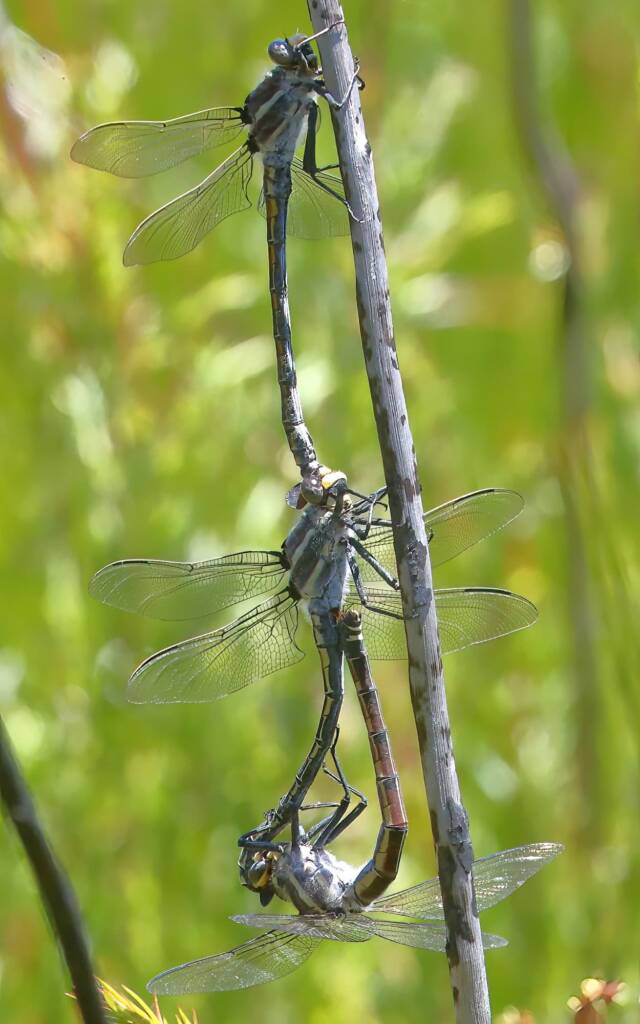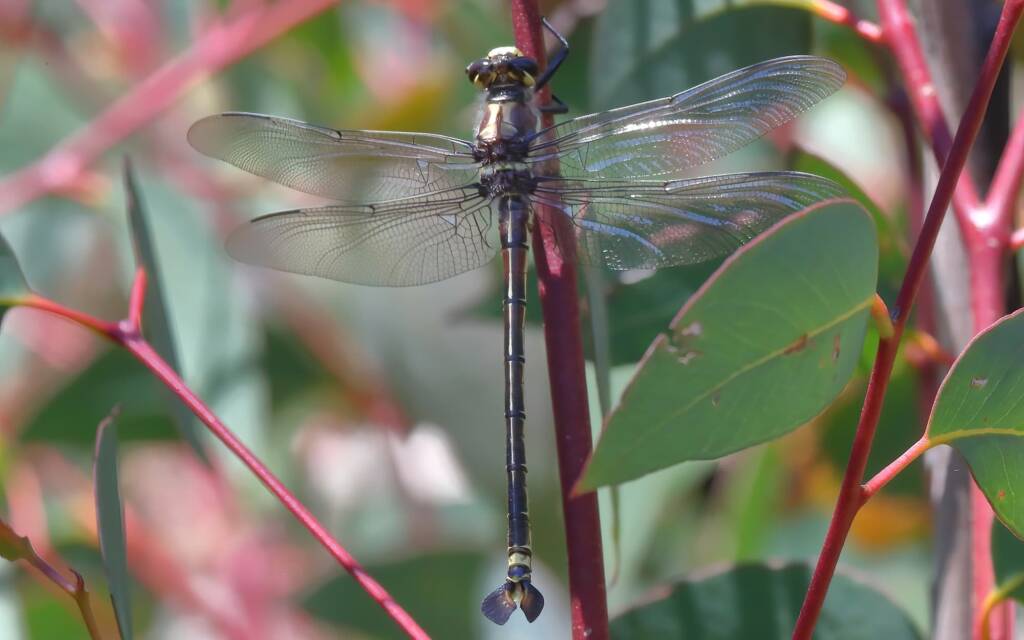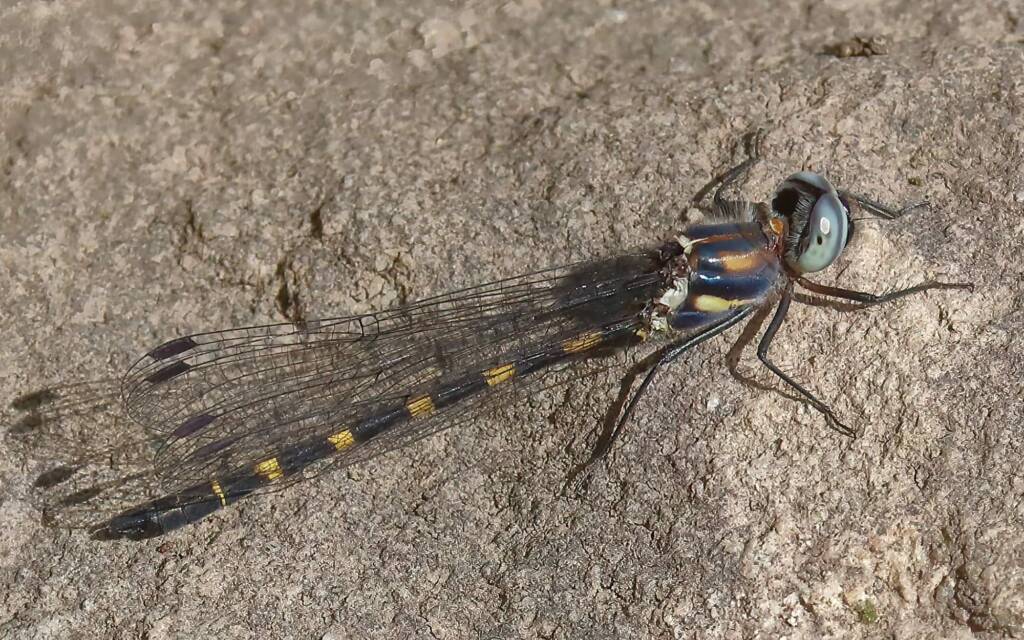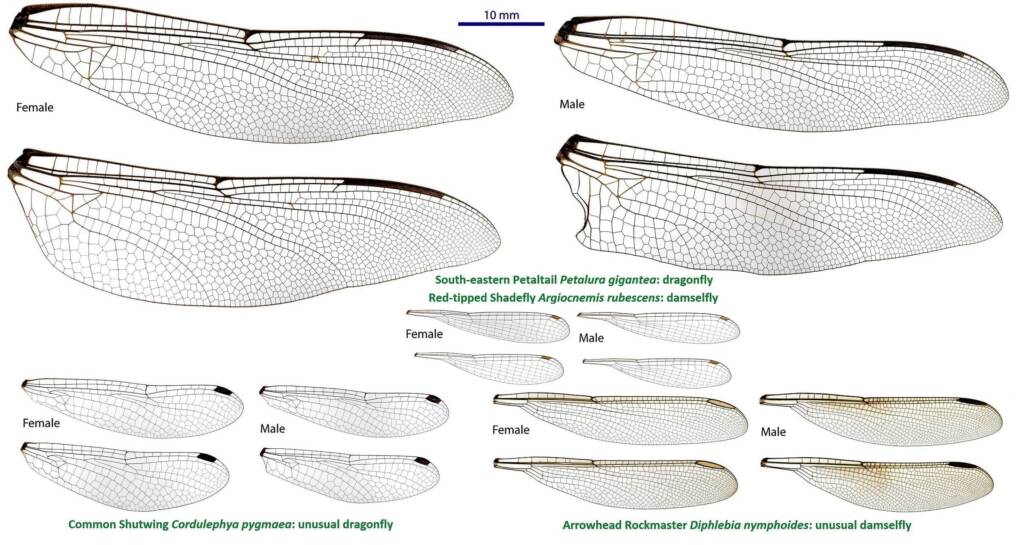Dragonfly or Damselfly?Side by Side The Little and Large Show The Shell Game Going to Extremes Side by Side answer Going Zen The Rule Acknowledgement of sources
Author Jeff Melvaine ◦
Quiz 4: Going to Extremes

South-eastern Petaltail (Petalura gigantea) male + pair, Blue Mountains NSW


Common Shutwing (Cordulephya pygmaea),
Lake Parramatta, Sydney metropolitan area NSW

Arrowhead Rockmaster (Diphlebia nymphoides) pair at Guy Fawkes River, Ebor NSW
There are three species above: which are dragonflies, and which are damselflies? Hint: two of them are shown in copula, and the name of the other can be read as a clue.
Quiz 4 SPOILER ALERT
The Petaltail copula is a bit unorthodox with an additional rather disorientated male trying to clasp the successful male’s head (which can happen with a number of other Odonate species). The view of the successful male’s grip is a bit obscure because as usual I was relying on telezoom (effective focal length 784mm) rather than close approach with a macro lens to capture the detail, and there was too much water for a closer approach anyway, but if you can enlarge the view on a laptop screen it becomes clearer that the male’s grip is on the female’s head. That establishes that this is a dragonfly species, and so does the angulation at the base of the hindwing to keep it clear of the auricle. Rather clearer in the individual photo of the male are the left forewing and hindwing triangles, which really prove the point. But you can also see that the eyes in this species do not meet in the middle of the head, nor do they dominate the head in the same way as the eyes of the Australian Emperor, and the Petaltail head is smaller in relation to the thorax.
The Rockmaster copula clearly shows that the male grip is on the female prothorax. So that establishes that this is a damselfly species. You could also infer that from the narrow stalks at the base of the male’s left wings; no dragonfly has that wing structure. The Rockmasters are the other Australian damselfly group that perch with wings open. They are bigger and more muscular than other Australian damselflies, possibly the most muscular damselflies in the world, and this raises the question of why other damselflies have not gone down this path. I’ll come back to that shortly.
The Shutwing looks like a dragonfly except for the closed wing posture, and the eyes meeting tightly at the top of the head are particularly persuasive. The name suggests that the wing posture is unexpected. I have never encountered a Shutwing copula, but here is one from iNaturalist:
At full magnification, this clearly shows the male epiproct pressed against the top of the female head, confirming that this is a dragonfly species.
There are a few paradoxes here which will make more sense when we have covered a bit more basic Odonate biology. But first, here is another wing comparison scale diagram for the three species in this quiz, with the Shadefly from Quiz 1 included as a “normal” damselfly:

Wings Composite Petaltail Shadefly Shutwing Rockmaster
Not so clear from the Shutwing photos is that the forewings are remarkably similar to the hindwings in shape and venation. An experienced entomologist would expect a damselfly’s forewings and hindwings to be almost carbon copies in shape and structure, and particularly at the base where all wings taper to a narrow stalk (except for the Demoiselles, family Calopterygidae, probably no Australian species although one has been claimed). The absence of narrow wing stalks, and the small but definite difference in width at the wing base in the Shutwings would therefore be persuasive that they are really dragonflies, reinforced by a look at the discoidal cell of each wing, which features triangles with only one corner cut off. But the simple description of dragonfly forewings and hindwings as dissimilar doesn’t capture those subtleties.
The Petaltails are notable as including the largest living Odonate (measured by overall bulk) in the world, this being the Giant Petaltail (Petalura ingentissima) from far north Queensland. But there are also very small dragonflies and very large damselflies. The title of smallest Odonate is attributed to a rare south-east Asian species Nannophyopsis chalcosoma, a dragonfly:
Only slightly larger in overall dimensions (and possibly lighter) is the world’s smallest damselfly. It’s an obscure member of the genus Argiocnemis, like the Shadefly featured in Quiz 1, but from Namibia. I cannot find a reference to it that quotes a scientific name, so it may be that it does not yet have one, or the proper formal description to establish that name.
The largest Odonate, as measured by wingspan and body length, is the Long-tailed Helicopter (Mecistogaster linearis), from tropical America. Although occupying a lot of space, the Helicopter damselflies are ever so much more lightly built than the Petaltails, which doesn’t exactly contradict all of the stereotype. They will come to our attention in another context shortly, but for now, here is an iNaturalist observation to demonstrate their slender build:
The Rockmasters are bulky in a way that the Helicopter damselflies are not. They look like they are comfortable with a dragonfly lifestyle, perching with wings outspread, and the males, although not as restless as the Australian Emperor and some similar large dragonfly species (which remain airborne for long periods patrolling their territory), will compete vigorously and at great length for their right to occupy a territory whenever a challenger approaches, in order to monopolise any female that approaches that territory. Their wings show certain resemblances to those of dragonflies; the nodus is strengthened, and closer to the middle of the wing, and the overall vein density is closer to that of the largest dragonflies (Petaltails and Giant Darners), as seen in the graphic above.
So why are they able to pursue this lifestyle when so many damselflies are restricted to less bulk and a less combative life? This brings us to a fundamental defining characteristic that separates dragonflies and damselflies. Most odonate larvae (Rockmasters included) live immersed in water. Like fish, they need to be able to extract oxygen from that water, in order to live and grow. The larval stage is where all the real growth happens; at each moult the newly emerged insect will seize the opportunity to expand itself beyond the limits of the shell it leaves behind, on a now or never basis because the external skeleton is rigid. The more oxygen they can absorb from their environment, the larger they can grow without exhausting their oxygen supply. Dragonfly and damselfly larvae have significantly different ways of doing this.
The usual simple explanation is that dragonfly larvae breathe through internal gills, while damselfly larvae breath through external gills in the form of three tail lobes. Dr. Tillyard, dynamic local pioneer of Australian Odonatology in the early 20th century, found the first statement substantially correct, but the second in need of a rethink.
The dragonfly internal gills, assisted by strong pumping muscles, can supply all the oxygen required by large robust larvae. The Petaltail larvae (Petalura) are amphibious (given suitably damp air) and live in muddy burrows that connect to water in the hanging swamplands and streams in other high water table areas they inhabit, and also to land on the banks; they can take prey from both environments. The substantially smaller Mistflies (Pseudocordulia) can even survive as larvae in moist leaf litter, in misty cloud forest where the moisture level is consistently renewed. More normally, dragonfly larvae can utilise the lower oxygen levels in stagnant and slow-flowing water far more effectively than damselfly larvae, which allows dragonfly bodies to grow to be much larger and more robust in that type of environment.
Odonate internal gills are located in the rectum, and the pumping action of the dragonfly respiratory muscles is sufficient to provide a form of jet propulsion to help them escape predators when used underwater. The respiratory function is not compromised by faeces, which arrive in the rectum prepackaged in a protein sheath, and can be fired out ballistically by the stay-at-home Mistfly larvae to keep their immediate environment free of junk.
Typical damselfly larvae can survive the loss of all three tail lobes, provided that it does not happen too many times. Yes, the curiosity of the scientific researcher has its ethical dilemmas; the experiment to establish how many times is too many must end in the death of the larva. Back in the real world, a similar loss of tail lobes may result from a damaging bite by a would-be predator sneaking up from behind, but not collecting all of its victim. All odonate larvae can absorb dissolved oxygen directly through the external body surface, and in excessively oxygen-poor water (e.g. a severely shrinking pool in a drought) they may rise to the surface to absorb oxygen directly from the damp air layer at the surface, while keeping the body surface damp. A long slender body shape, characteristic of typical damselfly larvae, maximises the area through which oxygen can be absorbed, by comparison with a more compact shape having the same volume.
Damselfly larvae have rectal gills, although these are much less efficient without the pumping ability of dragonflies. They lack the capability for jet propulsion, but in several groups the tail lobes are fin-like and assist swimming. Spiracles (respiratory openings more useful to air-breathers) and external lateral gill structures are also relevant for damselflies in some cases; some non-Australian species from the genera Epallage and Cora can grow to be quite robust with the help of external gills on the flanks of several abdominal segments, in conditions where respiration would be difficult without that resource.
Rockmaster larvae do not have external flank gill structures like Epallage and Cora. To grow to the size and bulk of a medium-large dragonfly, they need more oxygen than conventional damselfly gills can supply. They have met that need with large, bulbous tail gill structures, primarily specialised for respiration, and by occupying water that is cold, turbulent and fast-flowing. Oxygen is more soluble in cold water, turbulence helps to dissolve more of it, and fast flow delivers more of it to the larva per unit of time. Here is a Rockmaster larva sighting from iNaturalist to show the general shape:
Rockmaster larvae are not particularly agile hunters; they cling to the underside of rocks, where the gills can also play a role in anchoring them so they are not swept away by the current, and grab passing victims. I recall a visit to Crystal Cascades near Cairns, only a week after Tropical Cyclone Owen had cut across far north Queensland dumping vast amounts of water; Freshwater Creek was thundering downstream around massive boulders, and the Tropical Rockmasters (Diphlebia euphoeoides) were there in battalion strength, as though daring the waters to try and stop them getting on with the next generation.
That species has an interesting adaptation to Australia’s characteristically sporadic rainfall; it has been found in larval form buried in dry creek beds, alive but inert, seemingly in the style of the Burrowing Frog. The two sister species that resemble it most closely (D. coerulescens and D. nymphoides) are quick to recolonise dry creeks in the Toowoomba district when rain restores them to flowing condition after a lengthy period as dry ground. Fast running water is not a commodity to be taken for granted in Australia, even close to the Great Dividing Range.
Similar principles, applied in reverse, are relevant to the four Australian species in the Shutwing genus Cordulephya, which are the only dragonflies in the world that adopt a tented wing perching posture, with the leading wing edges close together above the abdomen, and the trailing edges by the respective sides of the body, held just above the substrate, giving good clearance above the ground and below any overhanging vegetation. That same wing posture, characteristic of stout cicadas and more slender lacewings, is used by many damselflies, although they may also choose to clasp all four wings flat together, beside or entirely above the abdomen, or clasp one pair together above the other pair.
The four tropical American species of Sapphirewing dragonflies, Zenithoptera, live up to their scientific name by sometimes perching with all four wings flat together pointing skywards, or angled rearwards somewhat like a typical Demoiselle damselfly (Calopterygidae). Sapphirewings do this to expose the black lower surface of their wings, which makes them much less conspicuous than when they revert to the normal dragonfly wing posture displaying the brilliant blue upper surface. They are remarkable for being able to achieve all of this (but not the tented posture) with a typical dragonfly wing shape, with one significant modification: the base of each hindwing is contoured to curve away from the abdomen in the closed position.
- https://inaturalist.ala.org.au/observations/121531610
- https://inaturalist.ala.org.au/observations/121531612
All other mature dragonflies perch with wings open, although some may vary the posture to a degree by hunching the wings forward.
The photo of the male Shutwing emphasises some other interesting features. The head is tall in relation to the prothorax, in typical dragonfly style, supporting large compound eyes that meet along the midline of the head and face directly forward, but the synthorax slopes back at a very flat angle, rather more in the typical damselfly style.
As if their wings were not sufficiently unusual, three of the four Cordulephya species emerge as adults in late summer and their flight time extends well into winter (the other, C. montana, emerges somewhat earlier). This seems like a good way to avoid the attentions of nesting insectivorous birds in spring and summer, which could compensate for the sacrifice of some of the advantages of high-performance dragonfly wings. A more typical dragonfly could not outpace or outmanoeuver a specialist insectivorous bird in the majority of cases, but a significant question for survival is how much of its energy reserves the predator uses in overtaking its prey. Easier targets need to rely on synchronised emergence in sufficient numbers to ensure an adequate survival rate, and the Cordulephya iNaturalist sighting referenced above was one of a significant sudden burst at that and several other locations.
Shutwing larvae are found in silt, which tends to accumulate in places where the current is not strong. This would give an advantage to dragonfly larvae with their pumped gill respiration, relative to the more passive respiratory strategies of typical damselfly larvae. It looks as though Cordulephya dragonflies have found it useful to adopt some features of the damselfly lifestyle, without sacrificing other aspects of the dragonfly lifestyle that are most advantageous to them. This is an interesting inversion of the lifestyle adaptations of the Diphlebia damselflies.
An interesting question regarding a different kind of inversion is this: if Cordulephya is a dragonfly with forewings and hindwings unusually similar, are there any damselflies with forewings and hindwings unusually different? Not in Australia, but again tropical America offers a striking example, Microstigma rotundatum:
These “Helicopter damselflies” excel at slow precision flying with short fast dashes to snatch orb-weaving spiders and the spider’s silk-wrapped prey from their webs, and their long wings and abdomen work well for this purpose.
Pseudostigma (as in their former family name Pseudostigmatidae) means “false pterostigma”, and pterostigma means “wing mark”. The wing mark in question is a hardened and often darkened area, filled with haemolymph (Odonate blood), along the leading edge of the wing near the tip, a mere spot in some species, but more like a long stripe in others, particularly the Petaltails. Its purpose appears to be to add weight to the wing in a critical place to damp down unwanted vibration at the front of the wing (“flutter”), which if not counteracted can reduce the speed achievable when gliding rapidly. Some overseas damselflies (including the Papuan Demoiselle, Neurobasis australis mentioned above) don’t have pterostigmata or anything like them; some replace them with pseudostigmata, which are marks, often colourful, that extend the wing area, but don’t have the regular structure of pterostigmata.
Helicopter damselflies do not need to glide at speed, but mostly flap their wings slowly. In the species shown above, the hindwing is transparent with a simple black pterostigma covering three cells; the forewing has a large black and yellow area of pseudostigma, and is slightly larger than the hindwing.
Quiz 4 TLDR Summary
A significant difference between dragonflies and damselflies is the efficiency of their larval respiration systems; dragonfly larvae have a big advantage in being able to pump water through their internal gills. The faster the water goes past the gills, the more oxygen they have access to. Damselfly larvae must rely on a variety of more passive strategies to extract enough oxygen from the water in which they live.
The largest dragonflies, the Petaltails, have an unusual take on this: their larvae can hunt in damp air or in water, and live in muddy burrows from which both environments are accessible.
A long slender shape means more surface area in proportion to body mass, assisting passive (non-pumped) respiration. This carries over into the adult body form of typical damselflies, and is taken to extremes in some of the less typical (the Helicopter damselflies), which have longer wings and bodies than the largest dragonflies, without coming anywhere near the same body mass. This helps typical damselflies to survive in freshwater habitats that have poor to moderate oxygen levels (ponds, lakes, and watercourses with slow to moderate flow), but limits them to significantly lower body mass than typical dragonflies. In cold, fast and turbulent water, the oxygen content is higher, and delivered more rapidly to anything that can manage to keep still. In this way, the Rockmaster damselflies can surpass some of the limitations of passive respiration and grow to the size and robust build of quite a large dragonfly, by choosing cold fast rocky streams as their breeding sites. There are some dragonfly-like aspects of their wings too, although that does not affect the discoidal cell.
The Shutwing dragonflies have gone in the opposite direction. They have adopted a closed wing posture when perched, with the forewings unusually similar to the hindwings to avoid damage when closing them. They breed in silty areas, where the current is not brisk, and can derive benefits from their pumped respiration that damselflies are denied.
Just to complete the tableau of oddities with a non-Australian example,, some Helicopter damselflies have forewings noticeably different from the hindwings. This has to do with their need to fly precisely when snatching orb web spiders from their webs; they don’t glide, and can do without the special wing mark (pterostigma) that helps to suppress flutter when gliding, if a different structure will work better for their flying style.
Dragonfly or Damselfly?Side by Side The Little and Large Show The Shell Game Going to Extremes Side by Side answer Going Zen The Rule Acknowledgement of sources
Footnote & References
- Author Jeff Melvaine / Photographs © Jeff Melvaine
- Wings Composite Petaltail Shadefly Shutwing Rockmaster, Source: John Tann, Wikipedia
Dragonflies & DamselfliesDragonfly or Damselfly? Sex Lives and Dragonflies Damselflies Diplacodes haematodes Hemicordulia tau Orthetrum caledonicum Orthetrum migratum Orthetrum villosovittatum
InsectsBees Beetles Blattodea Butterflies Coleoptera Cicada Crabronidae Diptera Dragonflies & Damselflies Formicidae Hemiptera Heteroptera (True Bugs) Mango Planthopper Moths Orthoptera Orthopteroid Processionary Caterpillar Stink Bugs, Shield Bugs and Allies Syrphidae Wasps Water Scorpion (Laccotrephes tristis) Witchetty Grub
